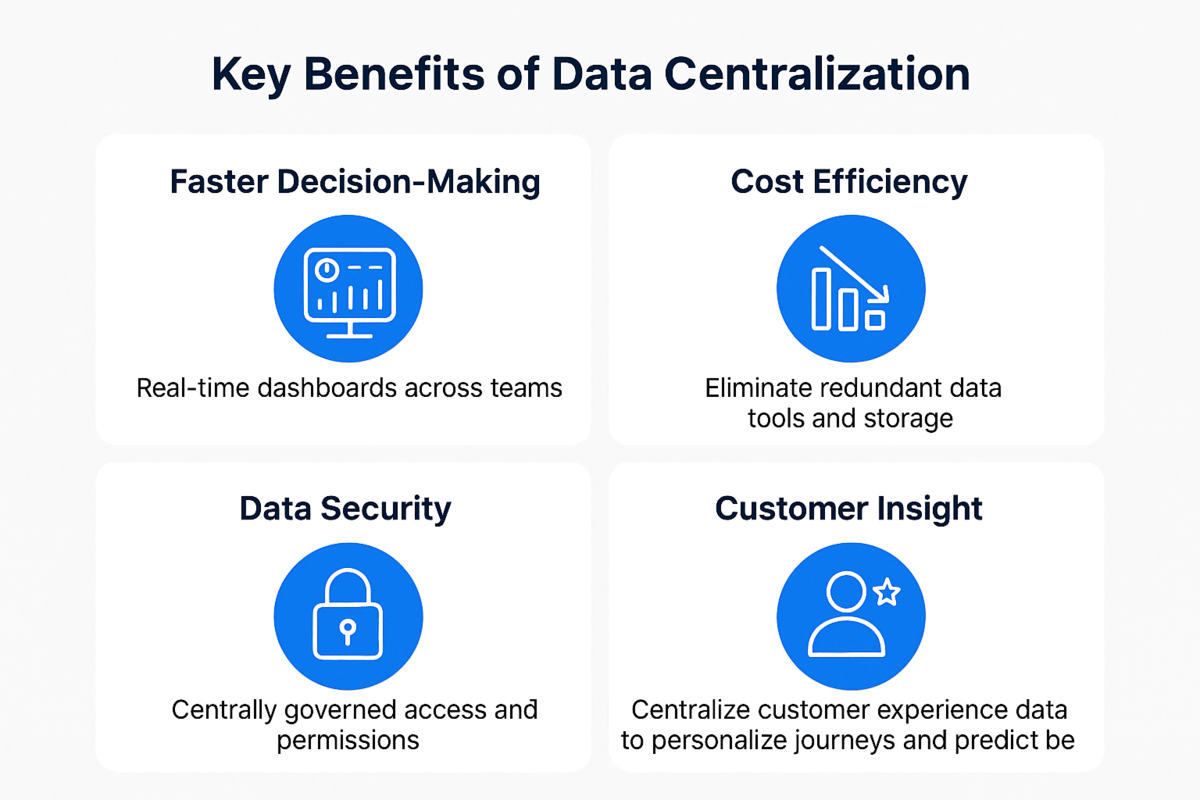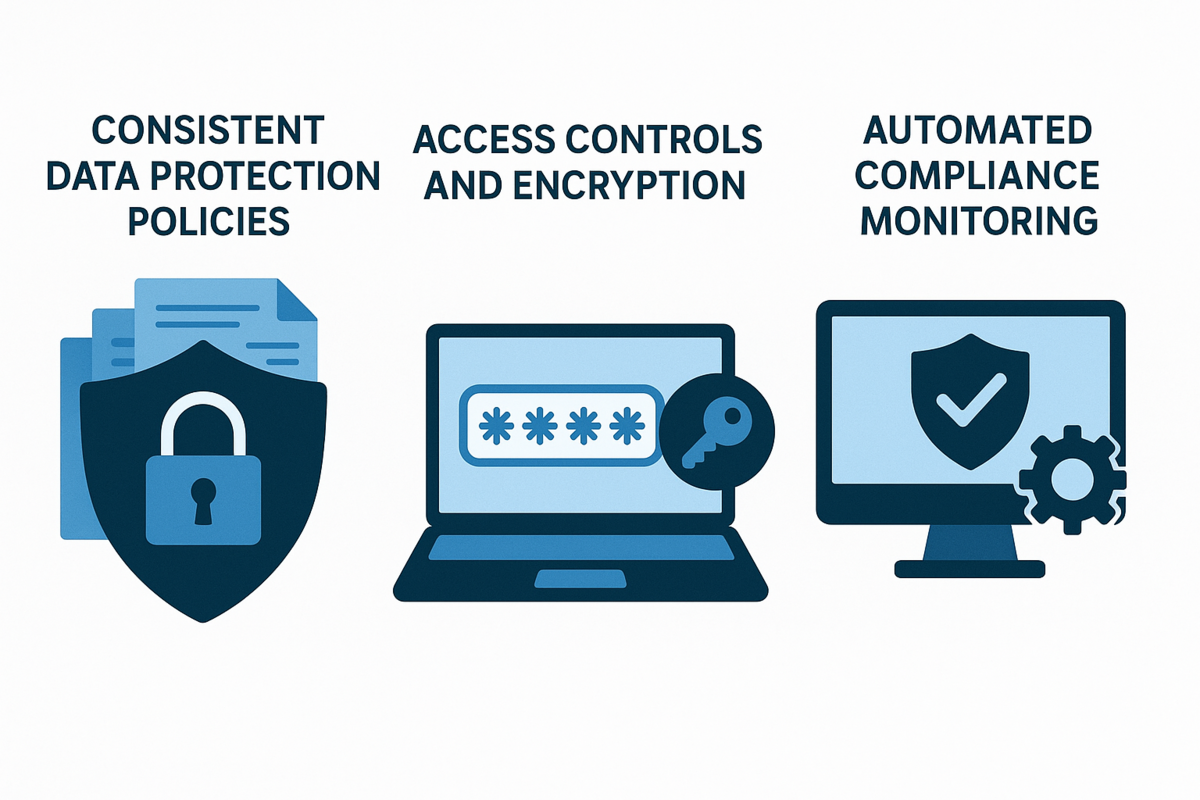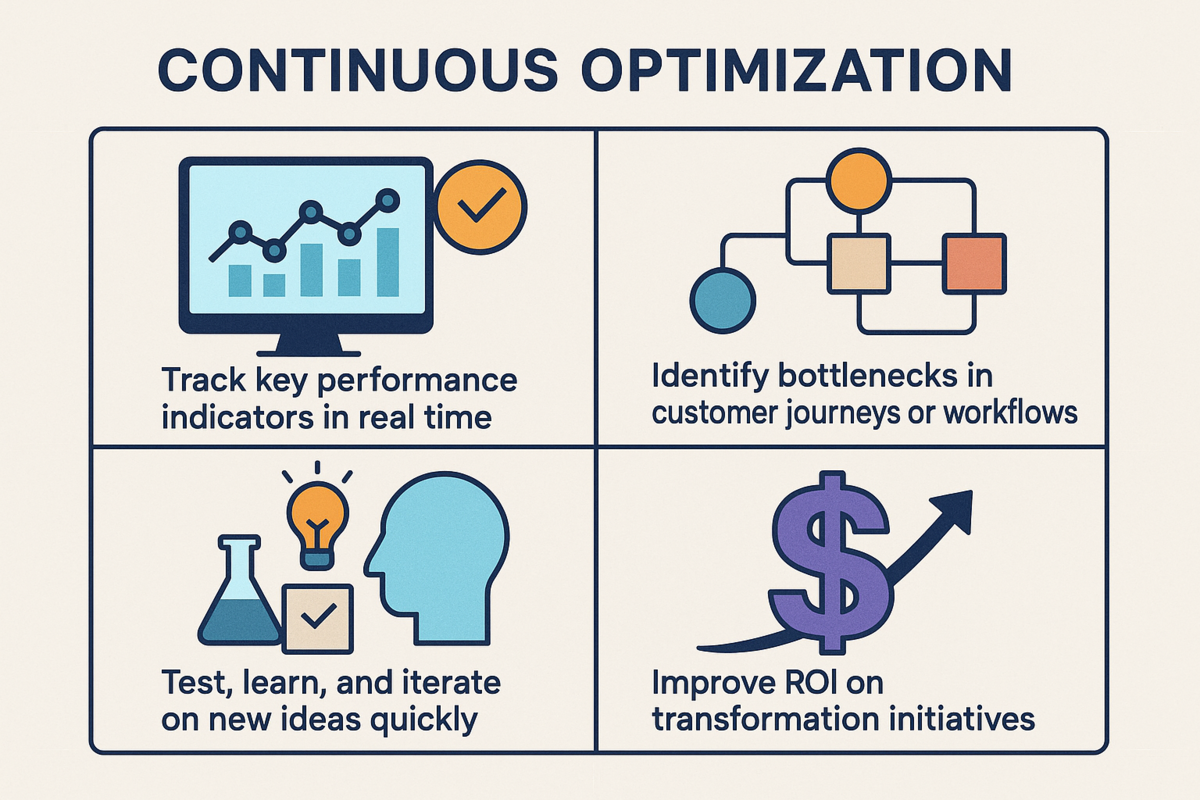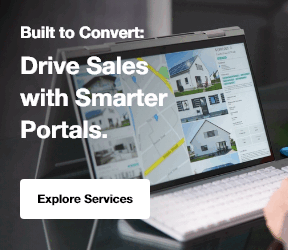In today’s fast-shifting digital landscape, 70% of digital transformations fail due to poor strategic planning and misaligned goals (McKinsey).
To compete at scale, whether you're in oil and gas, automotive, or media and entertainment, transformation can no longer be viewed as a one-time project.
It must be approached as a holistic, ongoing initiative rooted in cross-functional strategy and smart execution.
At the heart of every successful transformation lies a clear blueprint, one that aligns technology with business outcomes, centralizes operations for visibility, and empowers innovation through agility.
Whether you're a luxury brand aiming to elevate customer experience or a banking enterprise optimizing internal systems, the fundamentals remain the same.
This article explores the 10 key elements of a digital transformation strategy, highlighting how digital transformation services integrate scalable solutions like centralized data platforms, cloud security, and customer unification.
If you're serious about making technology an enabler, not a barrier, then it's time to build a transformation roadmap that doesn’t just check boxes but drives measurable impact.
What Is Digital Transformation?
Digital transformation is the strategic integration of modern technologies into every aspect of an organization’s operations. Its purpose? To completely redefine how businesses operate, compete, and deliver value to customers.
It goes far beyond basic digitization, the simple act of converting physical assets (like paper records) into digital form.
And it’s more than digitalization, which focuses on using digital tools to streamline existing processes. Digital transformation is broader and more holistic. It’s about rethinking business models, restructuring workflows, and reimagining customer engagement from the ground up.
At its core, digital transformation demands a fundamental shift in how organizations function. This means taking a critical look at both internal processes and external customer touchpoints to embed digital thinking and technologies at every level.
The ultimate goals? To boost performance, improve profitability, enhance customer satisfaction, and build a more agile, innovation-ready organization.
In today’s hyper-connected and highly competitive market, adopting digital technologies is no longer a luxury, it’s a necessity.
Organizations that cling to outdated systems risk falling behind, while those embracing digital transformation gain new avenues for growth, speed, and resilience.
By investing in modern digital capabilities, businesses can operate more efficiently, make smarter, data-driven decisions, and quickly respond to changing customer demands.
Looking ahead, several key technologies, both emerging and foundational, are driving this shift and will continue to shape the future of digital transformation strategies. These include tools like artificial intelligence, cloud computing, automation, big data analytics, and more.
10 Key Elements of a Digital Transformation Strategy
Digital transformation isn’t just about adopting new technologies, it’s about aligning innovation with business goals to create lasting value.
To succeed, organizations need a clear, well-structured strategy that guides every step of the transformation journey.
From leadership alignment to data-driven decision-making, each element plays a critical role in driving change and ensuring long-term impact.
Below are the 10 key elements every business should focus on when developing a digital transformation strategy.
The components of digital transformation often overlap with these elements, forming a robust digital transformation strategy framework for success.
1. Executive Alignment & Vision
Successful digital transformation begins at the top. Without clear direction and unified leadership, even the most advanced technology implementations risk falling apart. True transformation demands more than just digitizing existing processes, it requires redefining how your business creates value in a tech-first world.
Why It Matters?
When leadership is aligned on a transformation vision, it establishes a unified front. This clarity ensures that digital initiatives are not siloed experiments, but enterprise-wide business strategies in digital transformation tied directly to key performance indicators (KPIs)
A well-communicated vision:
- Sets expectations and goals across departments.
- Drives cultural buy-in from teams at every level.
- Keeps everyone focused on outcomes, not just outputs.
Use Case Example
In industries like real estate, travel, and tourism, executive alignment can make or break efforts to implement intelligent automation or launch omnichannel digital platforms. If the CEO is pushing for innovation but department heads still rely on outdated legacy systems, transformation stalls.
The Approach
Digital Transformation Services are rooted in aligning business goals with scalable digital strategies. We work directly with executive stakeholders to:
- Define vision and transformation scope.
- Map digital capabilities to revenue-generating objectives.
- Ensure C-suite leadership is involved from discovery to deployment.
This executive-led approach leads to stronger governance, faster execution, and sustainable transformation success.
Explore Our Digital Transformation Services!
2. Clear Business Objectives Aligned to KPIs
Digital transformation without clearly defined business objectives is like setting sail without a destination. To ensure measurable success, organizations must anchor every digital initiative to specific KPIs that reflect real-world business outcomes, not just technical milestones.
Why It Matters?
Objectives guide prioritization. KPIs ensure accountability.
While many businesses focus heavily on digital performance, it's worth noting what are five marketing strategies that retailers spend half of their annual budget on? understanding these core tactics helps inform digital objectives that are grounded in proven ROI.
Whether you're in the food and beverage sector, optimizing logistics, or a non-profit aiming to boost donor engagement, clarity around outcomes is essential. Objectives like "improve customer retention by 15%" or "reduce operational costs by 20%" give digital transformation efforts purpose and performance benchmarks.
Common Transformation Goals Include:
- Reducing time-to-market for digital products.
- Enhancing customer experience and satisfaction scores.
- Increasing process automation to minimize manual effort.
- Unlocking new revenue streams through digital channels.
Use Case Example
In the automotive industry, a manufacturer might implement a centralized IoT monitoring system to reduce downtime in assembly lines. The objective isn’t just to install new software, it’s to achieve a quantifiable drop in production losses, tracked via real-time dashboards.
The Approach
By helping clients define SMART digital objectives (Specific, Measurable, Achievable, Relevant, Time-bound) and connect them directly to:
- Real-time data from centralized platforms.
- Actionable dashboards and automated reporting.
- User behavior analytics aligned with KPIs like conversion rate, bounce rate, or Net Promoter Score (NPS).
No matter the sector, luxury brands, banking, or technology, our KPI-first strategies ensure your digital investments drive real impact, not just vanity metrics.
Strategies for digital transformation tie directly to these objectives for measurable results.
Developing a digital transformation strategy means setting goals that align with business priorities.
For instance, a 2025 McKinsey report notes that companies with clear KPIs achieve 25% higher ROI on digital projects
3. Centralized Data Management
At the center of every successful digital transformation is a single source of truth: one place where business-critical data is collected, stored, managed, and analyzed. This is the power of centralized data management—enabling smarter decisions, real-time collaboration, and actionable insights across the enterprise.
Why Centralized Data Matters?
Dispersed data leads to misalignment. Centralizing data ensures that every stakeholder, whether in marketing, operations, or finance, works from the same information. For industries like banking and finance, where accuracy and compliance are paramount, this is non-negotiable.
With a centralized data repository, companies can:
- Break down silos between departments.
- Ensure data quality, consistency, and integrity.
- Enable real-time reporting and predictive analytics.
- Improve data privacy governance and security compliance.
According to Deloitte, organizations that use centralized data platforms are 2.2x more likely to exceed their business goals.
Use Case Example
A media and entertainment company may pull audience metrics from multiple channels—social, streaming, web, and mobile. Centralizing that data into a unified platform allows for hyper-personalized campaigns and optimized ad spend. Without this, decisions are made in the dark.
Key Benefits of Data Centralization

- Faster Decision-Making: Real-time dashboards across teams.
- Cost Efficiency: Eliminate redundant data tools and storage.
- Data Security: Centrally governed access and permissions.
- Customer Insight: Centralize customer experience data to personalize journeys and predict behavior.
Role in Data Centralization
Web Design & Development team doesn’t just build websites, we architect data ecosystems that power growth. Through:
- Centralized integration of APIs across platforms.
- Enterprise-grade databases and structured repositories.
- Custom data governance models tailored to compliance standards in sectors like technology, oil and gas, and real estate.
Your business doesn’t just centralize data, it activates it to unlock strategic growth.
4. Cloud-Ready and Scalable Infrastructure
You can’t transform an outdated architecture. A modern digital transformation strategy needs a cloud-ready, scalable infrastructure that supports agility, speed, and innovation across departments, locations, and even time zones.
Why Scalability Is Crucial?
As businesses grow, so does their data, their customer expectations, and their operational complexity. Legacy systems buckle under these pressures. Cloud infrastructure, on the other hand, enables:
- On-demand scalability without added hardware costs.
- Global availability with minimal downtime.
- Security, compliance, and disaster recovery baked in.
Gartner predicts that by 2027, over 85% of businesses will adopt a cloud-first principle for all digital decisions, just as users have already shifted toward relying on top search engines for real-time access, scalability, and performance.
This shift is especially impactful for high-growth industries like the technology industry, travel and tourism, and luxury retail, where digital performance is tightly linked to customer experience.
Use Case Example
Consider a food and beverage company expanding internationally. A cloud-based ERP system allows teams across geographies to collaborate in real-time, share inventory data, sync procurement, and ensure compliance—something impossible with traditional on-premise setups.
The Approach to Infrastructure
As part of Creative Services and digital transformation planning, it deploys:
- Cloud-native architectures using platforms like Azure and AWS.
- Microservices-based design for scalable feature releases.
- Automated deployment pipelines for continuous delivery.
Combined with centralized IT governance, your infrastructure becomes not just future-proof, but innovation-ready.
We align your tech stack with your growth trajectory, whether you're a startup scaling globally or an enterprise overhauling legacy systems in regulated industries like banking and finance or energy.
Cloud platforms are critical digital technologies to be implemented in many transformation plans.
Digital transformation techniques include adopting cloud solutions for better access and scalability.
A 2025 Statista report projects the global cloud computing market to reach $1.6 trillion by 2030, growing at a 17.5% CAGR.
Explore Our Digital Marketing Services!
5. Seamless System Integrations for Cross-Department Connectivity
No digital strategy can succeed in isolation. Your CRM, ERP, marketing automation tools, financial systems, and customer portals must talk to each other in real time. That’s where system integration becomes the engine behind transformation.
Why Integration Is a Game-Changer?
Disconnected systems lead to duplicated data, inconsistent reporting, and frustrating user experiences, internally and externally. Seamless integrations allow every tool and team to work in sync, leading to:
- Unified data streams across departments.
- End-to-end workflow automation.
- 360-degree visibility into customer and operational data.
Seamless integrations allow every tool and team to work in sync, leading to more complete user tracking, much like what is the digital marketing strategy that tracks users across the web?, retargeting methods that rely on unified data flow and systems integration.
According to MuleSoft, companies lose an average of $8.2 million annually due to disconnected systems and integration issues.
Industries like oil, gas, and renewables especially benefit from cross-department integrations, where real-time access to field data, operations dashboards, and finance systems is mission-critical.
Use Case Example
A real estate firm uses separate platforms for listings, lead capture, CRM, and marketing campaigns. Integrating these systems into a centralized platform enables real-time updates, synchronized sales activities, and automated follow-ups, drastically improving conversion rates.
The Role in Integration
The priority integration in Digital Marketing and SharePoint Consulting projects by:
- Designing API-first architectures for easy interoperability.
- Building custom middleware to bridge legacy systems with modern platforms.
- Creating centralized dashboards with unified KPIs across teams.
Our solutions ensure data is centralized, systems are communicative, and workflows are frictionless, especially in complex operational environments like automotive, non-profits, or enterprise software firms.
6. Unified Customer Experience Platforms
Today’s customers expect more than just good service, they demand seamless, personalized experiences across every digital touchpoint. A disjointed experience can erode trust and push users toward competitors. That’s why a successful digital transformation must include a unified customer experience platform that integrates data, content, and communication channels.
Why It’s Critical?
From first click to final conversion, every interaction should feel connected, drawing inspiration from successful advertisement examples that use cross-channel branding to maintain customer trust and loyalty.
Unifying these touchpoints enables:
- Consistent brand messaging across channels.
- Personalized user journeys based on centralized customer data.
- Increased engagement and conversion rates.
A report from PwC found that 73% of customers point to experience as a key driver of brand loyalty, second only to price and product.
Industries like luxury brands and travel and tourism are particularly reliant on emotionally engaging, end-to-end experiences. Every second of friction online could be a lost sale or missed booking.
Use Case Example
A technology company that sells B2B SaaS solutions may run multiple platforms for lead gen, onboarding, customer support, and renewals. By unifying all touchpoints under one customer data platform (CDP), the brand can create hyper-personalized onboarding paths, dynamic email journeys, and real-time support, all from a single pane of glass.
Unified Experience Design
Our Web Design & Development services go beyond aesthetics. We architect full-stack platforms that:
- Centralize customer insights into a single CRM or CDP.
- Enable cross-channel automation and retargeting.
- Power personalized content delivery based on user behavior.
Whether you’re a media and entertainment brand looking to increase viewer retention or a banking service aiming to optimize mobile onboarding, deliver scalable experience platforms that feel as intelligent as they are intuitive.
Transformational marketing strategy uses unified platforms to improve customer engagement.
Elements of a digital strategy prioritize customer platforms for consistent interactions.
A 2025 Gartner study predicts 60% of enterprises will adopt CDPs by 2027, boosting customer retention by 15%
7. Centralized Data Security Governance & Privacy Models
As digital transformation scales, so does the risk surface, especially when dealing with sensitive customer data or industry-specific compliance requirements. That’s why a robust centralized data security governance model is essential for every transformation strategy.
Why Centralized Security Governance Is Non-Negotiable?
Data breaches don’t just result in financial loss, they erode trust, damage brand equity, and can lead to hefty regulatory penalties.
A decentralized approach to data security leaves gaps between teams, tools, and access points. Centralized governance, on the other hand, allows for:

- Consistent data protection policies are in place across all systems.
- Access controls and encryption standards are enforced company-wide.
- Automated compliance monitoring for frameworks like GDPR, HIPAA, or PCI-DSS.
IBM’s Cost of a Data Breach Report reveals the average cost of a breach in 2025 was $4.45 million, a statistic that underscores growing concerns over privacy, making comparisons like DuckDuckGo vs Google increasingly relevant in enterprise governance conversations.
This is especially vital for sectors like banking, healthcare, and automotive, where compliance is tightly regulated, and downtime is expensive.
Use Case Example
A non-profit organization handling large volumes of donor data across multiple fundraising platforms can’t afford data silos. A centralized data privacy governance model ensures that donor information is protected, auditable, and compliant, without slowing down operations.
Governance-First Approach
Through our Search Engine Optimization and B2B Marketing Services, we implement:
- Centrally governed data models with role-based access.
- End-to-end data encryption and secure integrations.
- Custom compliance automation for regulated industries like oil and gas, finance, and real estate.
Identify the advantages of centralized processing, not only to enhance security but also to establish a framework for trust, transparency, and long-term resilience.
Digital transformation pillars include security as a foundation for safe operations.
Digital transformation IT strategy emphasizes governance to protect critical data.
For instance, a 2025 cybersecurity report by CrowdStrike noted that centralized governance reduced breach response times by 35%
8. Talent Enablement and Change Management
Even the most advanced digital systems will fail without the people to power them. Technology alone isn’t transformation, adoption is. That’s why empowering your teams with the right skills, tools, and mindset is critical to realizing long-term digital success.
Why People Strategy Is Central to Digital Strategy?
Without employee alignment and involvement, new systems are often underused, misconfigured, or resisted altogether. Change fatigue becomes a real threat, especially in fast-moving sectors like media, technology, or luxury retail.
Effective change management includes:
- Upskilling and reskilling employees in new digital tools.
- Building a culture of continuous learning and innovation.
- Encouraging cross-functional collaboration.
- Transparent communication to reduce fear and resistance.
A Prosci study shows that projects with strong change management are 6x more likely to meet or exceed objectives.
Use Case Example
A travel and tourism company implementing a centralized CRM platform needs its sales, support, and marketing teams to adopt new workflows. By investing in comprehensive training and leadership-led engagement, the business ensures smooth adoption and better ROI from its technology investments.
How to Drive Human-Centered Transformation?
The Digital Transformation Services don’t just deliver tools, we create adoption strategies that make them stick. We help organizations:
- Launch internal enablement campaigns during system rollouts.
- Embed change champions across departments.
- Develop customized onboarding and training journeys.
- Track adoption rates and provide iterative coaching.
For industries like automotive, real estate, and banking, our people-first strategies ensure that digital investments don’t just go live, they thrive.
Culture change and communication support talent enablement by preparing teams for transformation.
Team structure is critical in assigning roles for transformation tasks.
Elements of digital transformation include building teams with the right skills.
Digital transformation for dummies simplifies this as training people to use new tools effectively.
A 2025 LinkedIn report found that 78% of organizations investing in upskilling saw improved employee adoption of digital tools.
9. Agile Methodology & Rapid Innovation Loops
In the age of constant disruption, companies that can iterate quickly and pivot intelligently outperform those stuck in linear, outdated workflows. That’s where agile methodology becomes a key driver of transformation—not just in software development, but in business digital strategy itself.
Why Agility Is the New Competitive Advantage?
Agility means delivering value in small, frequent cycles instead of massive one-time rollouts. It creates space for experimentation, learning, and course correction, without derailing long-term goals.
According to PMI, agile organizations are 28% more successful in delivering digital transformation projects than those using traditional models.
Agile innovation loops allow for:
- Faster time-to-market for new features and services.
- Continuous feedback from users and internal stakeholders.
- Quick adjustments based on performance or market shifts.
- Risk reduction by catching issues early.
This is particularly impactful in high-velocity sectors like technology, media, or food and beverage, where customer preferences and competition evolve in real time.
Use Case Example
A luxury fashion brand launching a new eCommerce platform uses agile sprints to test checkout experiences, collect live customer feedback, and implement real-time enhancements, rather than waiting for a massive relaunch every quarter.
The Agile Execution Model
Agility is embedded in our Creative Services and development processes. We operate on:
- Short sprints with tangible deliverables every few weeks.
- Daily standups and retrospectives to maintain alignment.
- Customer and stakeholder feedback loops are built into every phase.
- Data-driven optimization in real-time, not after the fact.
Whether we’re building a centralized data platform, launching a new product for the automotive industry, or reimagining UX for non-profits, our agile approach accelerates impact while staying aligned with your evolving goals.
10. Continuous Data-Driven Optimization
Digital transformation isn’t a “set-it-and-forget-it” project. It’s a living, evolving process that relies on real-time data, ongoing analysis, and continuous optimization to ensure that business objectives are not only met—but exceeded.
Why Optimization Must Be Ongoing?
Once systems are centralized, experiences are unified, and infrastructure is modernized, the next step is to measure, refine, and improve. Without active data feedback loops, even the best strategies stagnate.
Forrester reports that companies that optimize based on real-time data insights are 23x more likely to acquire customers and 6x more likely to retain them.

Continuous optimization helps you:
- Track key performance indicators in real time.
- Identify bottlenecks in customer journeys or workflows.
- Test, learn, and iterate on new ideas quickly.
- Improve ROI on transformation initiatives over time.
Industries like banking and finance or technology, where speed and security are critical, rely on centralized business intelligence platforms to drive real-time decision-making across operations, marketing, and compliance.
Use Case Example
A digital-first media company with millions of viewers uses centralized data to optimize content delivery based on viewer habits. By monitoring watch times, bounce rates, and heatmaps in real time, they adjust content strategy weekly, keeping engagement high and churn low.
How To Enable Optimization at Scale?
Through B2B Marketing Services, we help organizations set up systems that:
- Centralize data collection across digital platforms.
- Create dashboards that visualize KPIs for leadership and teams.
- Run A/B testing and conversion tracking tied to business goals.
- Implement predictive analytics for proactive decision-making.
For industries like real estate, oil and gas, and travel and tourism, this level of insight means faster wins, less guesswork, and strategies that evolve alongside customer needs.
FAQs
What are the 5 essential components of digital transformation?
The 5 essential components include customer experience, operational agility, culture and leadership, workforce enablement, and technology integration. These elements work together to drive meaningful change in organizations.
What are the 7 pillars of digital transformation?
The 7 pillars of digital transformation are strategy, leadership, culture, technology, innovation, data, and customer experience. These pillars form the foundation for successful transformation initiatives.
What are the 5 D's of digital transformation?
The 5 D's of digital transformation are digitalization, digital transformation, data, disruption, and democratization. These key concepts focus on technology's role in reshaping industries.
What are the 4 pillars of digital transformation?
The 4 pillars of digital transformation are technology, data, people, and processes. Together, they support the development of innovative solutions and operational improvements.
Book Your Free Expert Consultation!
Conclusion
Digital transformation is no longer a trend, it’s a necessity. But transformation without strategy is just expensive change. The organizations winning in today’s digital-first economy are those that combine centralized data platforms, agile processes, and a unified vision to adapt faster, operate smarter, and deliver more value to their customers. Whether you're in oil and gas, real estate, luxury retail, or nonprofit services, the 10 key elements of a digital transformation strategy outlined here offer a practical blueprint for building a data-powered future.
These elements are grounded in modern principles like what is inbound marketing? and what is B2B lead generation, concepts that tie digital engagement directly to qualified revenue pipelines. At Centric, we don’t just help you go digital, we help you think digital, operate digital, and grow digital. From designing secure, centralized architectures to building engaging, data-driven customer experiences, our teams deliver the strategic depth and technical clarity required to transform with confidence. So, the real question is: Is your business ready to transform, or are you just reacting to change?








